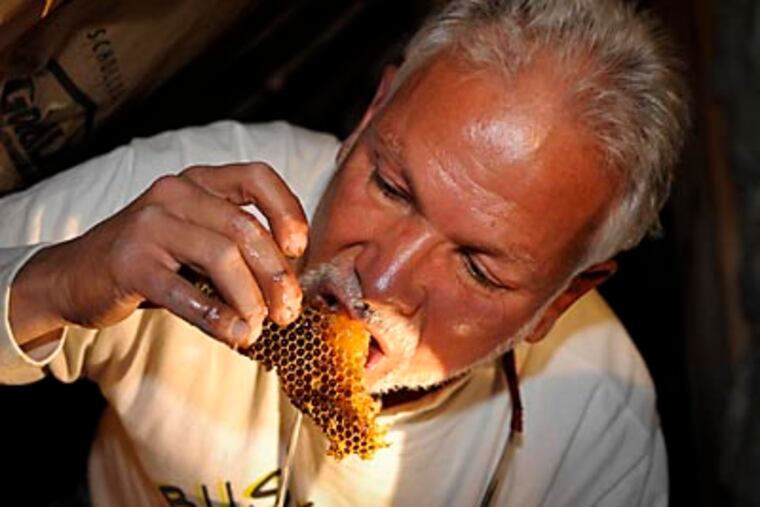30,000 honeybees removed from Cape May attic
CAPE MAY - Honeybee populations may be shrinking around the world, but that wasn't the case at Victoria Clayton's circa 1866 house, where a bee expert spent much of Thursday removing a huge wax honeycomb and 30,000 of the buzzing creatures from an attic crawl space.

CAPE MAY - Honeybee populations may be shrinking around the world, but that wasn't the case at Victoria Clayton's circa 1866 house, where a bee expert spent much of Thursday removing a huge wax honeycomb and 30,000 of the buzzing creatures from an attic crawl space.
Clayton and her boyfriend, Richard White, with whom she owns the former bed-and-breakfast on Washington Street, noticed an unusually large number of bees in their well-tended flower and herb gardens this spring. They also spied a constant stream headed toward a third-floor laundry vent.
After doing some research - and finding that honeybees are the "good" bees essential to pollinating many of the world's food crops - the couple decided to get help in herding their industrious visitors to a new home.
Clayton's infestation may be unusual in a global environment where a syndrome known as Colony Collapse Disorder began to worry scientists six years ago. Entomologists estimated that between 50 and 90 percent of the world's feral honeybee population had disappeared. Theories for their demise included the effects of decades of urbanization, pesticides, and parasitic mites.
But almost as soon as the word went out that bees were in trouble, environmentally concerned members of the public responded by becoming beekeeper hobbyists. Many established backyard apiaries, especially in Cape May County, said Tim Schuler, state apiarist for the New Jersey Department of Agriculture.
Thanks to a beekeeping course taught statewide by the Rutgers Cooperative Extension Service and sponsored locally by the Jersey Cape Beekeepers Association, the number of people who propagate bees in the county grew from 20 five years ago to more than 100 now, Schuler said. Statewide about 1,000 individuals belong to the New Jersey Beekeepers Association, double the membership of three years ago.
Clayton and White are not apiarists, but they have a close-up familiarity with the area's fauna.
"This old house just seems to attract wildlife, so it's good that I really love animals," said Clayton, 52, who regularly sees raccoons and possums, as well as hundreds of tiny black birds - known colloquially as "chimney sweeps" - that swarm her house at dusk, then dive-bomb single file down her dormant brick chimney to roost overnight.
The couple didn't want the honeybees exterminated, just relocated. Left alone, the hive - which measured three feet by two feet - would have continued to expand, producing so much honey that it would have seeped through the walls and floorboards, attracting other insects or rodents and rotting the historic home's soffits.
Enter Gary G. Schempp, 57, of Cape May Court House, who is so intrigued by honeybees - just honeybees, not bumblebees, carpenter bees, yellow jackets, or wasps - that he sold his 30-year-old pest-control business five years ago to deal solely with them. Schempp founded Busy Bees NJ, a honeybee rescue enterprise that aids inundated home and business owners.
Schempp, who maintains a vast apiary on his Route 47 farm, uses his old exterminator skills to locate bees inside walls, floors, crawl spaces, and other places, and charges a minimum of $500 a day to remove and relocate them. Some jobs take days, depending on the level of infestation.
On Thursday, Schempp found about 25 pounds of honey and nectar on the comb under the floorboards in Clayton's attic. None of it was suitable for consumption because it had been adulterated with dust and home insulation, he said.
"A comb this size and this active could have caused huge problems for this structure," he said. "It would have continued to get bigger and bigger inside the walls."
Schempp and his assistant, John Reed, arrived early with a variety of tools. They first engulfed the tiny space with a whiff of liquid smoke - meant to calm the bees. When bees detect smoke, they think the hive is threatened by fire and gorge themselves on honey until they're lulled into a state in which they're less likely to sting.
Next out were the hive boxes and lidded plastic pails into which Schempp placed pieces of the waxy comb covered by honey and bees. He then employed a special vacuum that gently pulled the insects into thick-meshed round cages with capacity for 10,000 bees - the better to transport Schempp's quarry back to his farm.
He brought along an apiary suit - which looks more like a space suit - and a supply of plastic gloves. But on this job, they went unused. He even shunned shoes, entering the crawl space in his stocking feet, jeans, and a T-shirt, despite being stung 35 times earlier in the week on a job in Haddonfield. His sting count for the day: a mere two.
Schempp never blames the bees for the stings, insisting that the species gets a bad rap from humans who don't understand their important role in the natural world.
Brought to the New World by early colonists, honeybees are a nonnative species that is responsible for pollinating up to a third of U.S. crops. While no precise figure is available, crops dependent on honeybee pollination - including apples, peaches, blackberries, cucumbers, almonds, strawberries, and other fruits and vegetables - have a total annual value in the tens of billions of dollars, according to the U.S. Department of Agriculture.